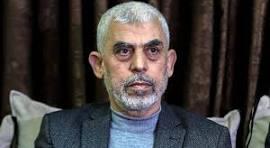Where are Hamas leaders now and seeing the cainage they caused to Gaza...

SURRENDER! SURRENDER! SURRENDER!
WANTED DEAD OR ALIVE- CRIME- KILLING OF 40,000 PALESTINIANS.


Hamas leaders are currently dispersed across several locations, with some residing in Gaza and others abroad. The main figures include Yahya Sinwar, who is believed to be hiding in Gaza, likely in underground bunkers due to the ongoing conflict and Israeli military operations targeting him and other Hamas leaders. Sinwar is considered a hardliner and was a key architect of the October 7 attack against Israel.
Ismail Haniyeh, another prominent Hamas leader, resides in Qatar. Haniyeh serves as the chairman of Hamas's Political Bureau and has been living in Qatar since 2017. He has maintained a significant role in directing the political strategy of Hamas from abroad.
Other Hamas leaders are spread across different countries including Lebanon, Syria, and Turkey, coordinating their actions and maintaining contact with the leadership within Gaza. The dispersion of Hamas leaders complicates efforts to neutralize their influence and operational capabilities.
The conflict has resulted in significant casualties and destruction in Gaza, with over 34,500 Palestinians reported dead since the start of the recent hostilities. Despite the heavy toll on Gaza's population, Hamas leaders like Sinwar continue to pursue their agenda, believing that the international attention garnered by the conflict serves their strategic goals.
The idea of Hamas publicly surrendering to save lives is a complex and contentious issue. Here are some key points to consider:
-
Potential Benefits:
- Humanitarian Relief: Surrender could halt ongoing violence, potentially saving many lives and reducing further destruction in Gaza.
- Peace Negotiations: It could open the door for renewed peace talks and possibly lead to a long-term resolution of the Israeli-Palestinian conflict.
- International Support: A gesture of surrender might garner international sympathy and support for the Palestinian people, leading to increased humanitarian aid and reconstruction efforts.
-
Challenges:
- Hamas Ideology: Hamas has a deeply ingrained ideological commitment to resistance against Israel, making the prospect of surrender highly unlikely. The group's leadership believes in the armed struggle as a means to achieve their goals.
- Internal Palestinian Politics: Surrender might be seen as a betrayal by many Palestinians who support Hamas's resistance against Israeli occupation. It could lead to internal conflicts and a power vacuum in Gaza.
- Response from Israel: While surrender might reduce immediate violence, the long-term political and security implications would need careful negotiation. Trust-building measures and guarantees of safety for Hamas members and their supporters would be crucial.
-
Historical Context:
- Past Ceasefires: Hamas and Israel have engaged in several ceasefires in the past, often brokered by international mediators. However, these ceasefires have been temporary and frequently broken due to ongoing grievances on both sides.
- International Pressure: Global powers and neighboring countries have exerted pressure on both Hamas and Israel to de-escalate conflicts. However, achieving a lasting peace requires addressing underlying issues such as the blockade of Gaza, Israeli settlements, and the broader Israeli-Palestinian territorial dispute.
The likelihood of Hamas leaders publicly surrendering is minimal due to their deeply entrenched ideological stance and the strategic implications of such an action. The leadership of Hamas, particularly figures like Yahya Sinwar and Ismail Haniyeh, are ideologically committed to their resistance against Israel. They view their actions as part of a larger struggle and believe that any form of surrender would undermine their cause and authority.
Moreover, surrender could be perceived as a significant loss of face and credibility within their own ranks and among their supporters. It might also lead to internal strife and a power vacuum in Gaza, complicating the governance and stability of the region.
Despite the enormous humanitarian cost, including thousands of Palestinian deaths and widespread destruction, Hamas's leadership remains steadfast in their approach. They believe that the international attention drawn by the conflict, even at great cost, serves their strategic objectives by keeping the Palestinian issue in the global spotlight.
In conclusion, while the humanitarian benefits of surrender are clear, the ideological, political, and strategic barriers make it an unlikely option for Hamas leaders at this time.
In summary, while the public surrender of Hamas could potentially save lives and lead to peace, significant ideological, political, and logistical hurdles make such an outcome unlikely. A more feasible approach might involve incremental steps towards de-escalation, increased humanitarian efforts, and sustained international diplomatic pressure.
- Questions and Answers
- Opinion
- Story/Motivational/Inspiring
- Technology
- Art
- Causes
- Crafts
- Dance
- Drinks
- Film/Movie
- Fitness
- Food
- Juegos
- Gardening
- Health
- Home
- Literature
- Music
- Networking
- Other
- Party
- Religion
- Shopping
- Sports
- Theater
- Wellness
- News
- Culture
- War machines and policy

